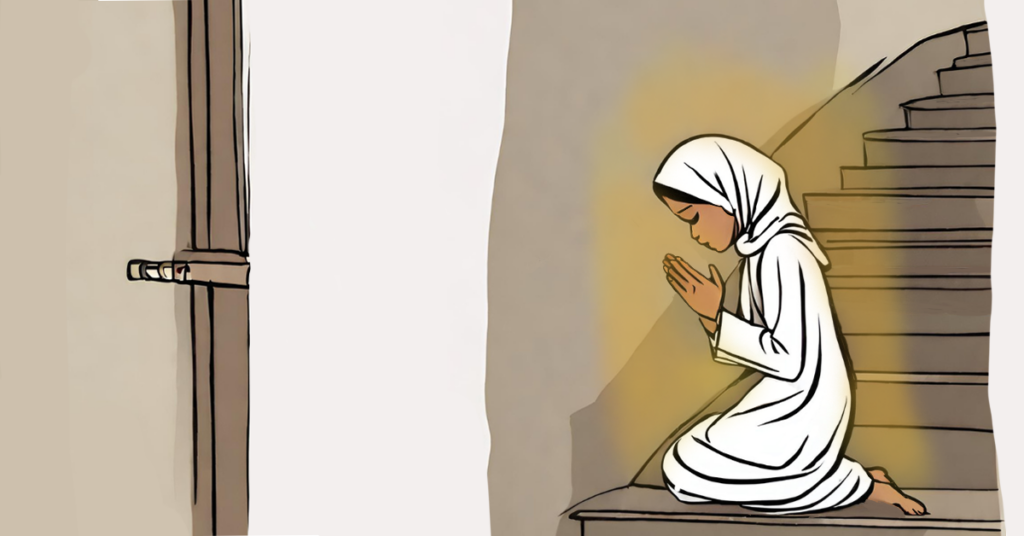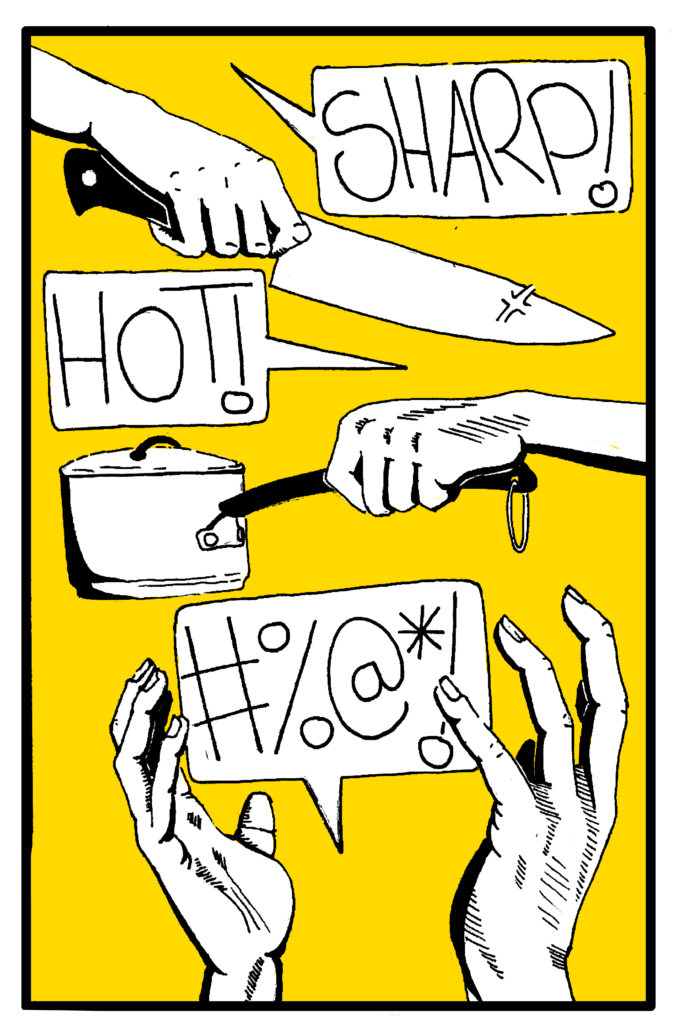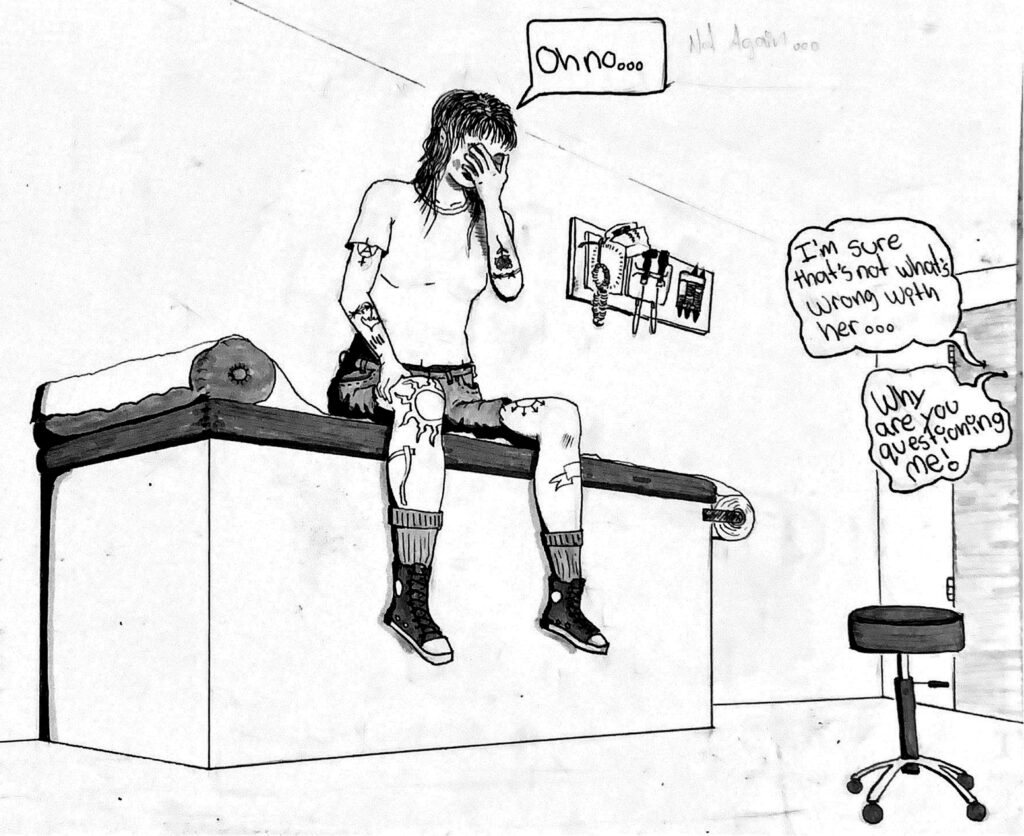BY GILLIAN JANE MCGREGOR
ART BY CALLIA SILVERTON
———————————————————–
In the summer of 2023, I found myself sitting at a coffee shop right below my apartment in De Pijp, a trendy neighbourhood in south Amsterdam. I wore silver knee-high boots and a patterned ruffle skirt. I was in Amsterdam for my dream fashion internship and I was practically being paid in clothes. I didn’t mind of course. That morning, I was admiring the difference between Dutch and Canadian fashions. Dutch women seem to be more playful with colour and have a charming, effortless look that stands out from the girls back home in Toronto. But what I really admired was the certainty and poise of elderly women in the city. I’d walk to and from my office on The Herengracht and spot small groups of them gossiping, shopping, drinking, and laughing, reminding me not only of the importance of lasting female friendships but also of a high-quality mohair spring coat.
They biked the cobblestone streets wearing floral wrap dresses over muted purple jeans so they could properly sit on their seats. Women in wheelchairs wore bright clay statement necklaces and acrylic glasses that looked delicately made from a local museum. Groups of elderly women walked and talked in multi-toned New Balance shoes and structured trench coats in between flower stalls and canals. The more I observed, the more I itched to shop.
The café seemed to be solely owned and operated by a middle-aged Turkish woman—a hard worker by the quick way she moved around—bringing black drip coffee to my table outside. I open my laptop and think back to the chic ladies I’ve seen around the city, searching “fashionable old ladies.” The internet disappoints me. It shows me articles with titles like Looks for Retired Living, and 9 Fashion Mistakes that Make You Look Older. A quick scroll through my curated Instagram feed and I notice two things missing.

The first is the lack of women over the age of fifty—it’s no secret that the models used to ‘influence’ people tend to be of a younger demographic. I seem to get older and older as I scroll while the girls in advertisements for anti-aging creams get younger. The second thing missing is a lack of individuality. This is less apparent, but disheartening all the same. Recurring themes appear in captions, comment sections, and headlines: Re-Creating this Pinterest Look; How to Achieve Hailey Beiber’s Date Night Fit; and Styles for Spring That Are Oh So Easy to Copy.
“When I returned to Toronto, suitcase bursting with new clothes, I continued to research my muse: fashionable old ladies.”
“Can I sit here?” My scrolling is interrupted by a slim woman in a thick, red pea coat, in twenty-degree heat, and a pair of gold architectural earrings. She takes the seat across from me. She stands out in her winter coat—my confusion is tied to my awe, it must have been fate. She appears to be about eighty years old and has grey-blue, deep-set eyes, with no makeup other than hours-old, orange-red lipstick. I am instantly intimidated, but also comforted by her thoughtful demeanour. I have the urge to tell her what’s been bothering me but at the same time, I want her to validate my outfit. The waitress asks what she would like in Dutch, but she answers in English, “A cappuccino.” We exchange small talk about my journey from Toronto to Amsterdam and she lights up when I discuss my fashion internship. I tell her I love her style. “I’ve had this coat for 30 years and I love it as much now,” she tells me.
I spent the remainder of my summer in Amsterdam admiring the perfect blend of refinement and individualism many of these older women share. So when I returned to Toronto, suitcase bursting with new clothes, I continued to research my muse: fashionable old ladies. During a morning ritual consisting of fashion blogs, celebrity updates, and a sprinkling of global news, I kept my eye out for women over the age of fifty on my feeds. Among the multitude of Hadid and Jenner campaigns, big personalities with gorgeous grey hair slip through the cracks. Women like eighty-six-year-old Vanessa Redgrave, who elevates Burberry’s traditionally serious campaign photos with a grin. This past October, eighty-eight-year-old Dame Maggie Smith graced the Loewe campaign wearing a fur coat and swept silver hair. And history was made when one-hundred-and-six–year-old, Apo Whang-Od posed on the cover of Vogue Philippines.
Accidental Icon
In a 2020 Kate Spade campaign, a jumbo, pistachio green handbag fills a deliciously pink background. Take a closer look and you can see a tiny yet expressive model. A silver bob and big sunglasses play with the bag with the same expression of excitement as a little girl with a new toy. Obsessed, I searched online for the women in the campaign. To my delight, I found an active fashion professional by the name of Lyn Slater, a slew of her editorials and wise words filling my screen. As an author, a professor of social welfare and a reformed social media influencer, my first impression of Slater was that she was an accomplished woman with a wardrobe to match. More than an influencer, the gems of Slater’s posts are found in her thoughtful and honest captions; the outfit pictures are merely a flavourful side dish to her writing. One post reads, “When you hear yourself saying, ‘I missed the boat. Or it’s too late for me to ____.’ Say this instead: ‘When I am old, I will do all the things I could never do before.’ I will become the person I was always meant to be.”
After scrolling through her Instagram, I’m refreshed by her wise words about style and aging. To me, Slater had the secret to a truly individualist approach to fashion.
In Peekskill, New York, United States, Slater finishes her daily walk. Some flurries fill the sky, but snow has yet to pile onto the ground. She’s returning from her local coffee shop’s twentieth-anniversary party, where she dons the cafe’s merch: a gray hoodie with the cafe’s logo on the front, a coffee bean bumblebee on the back, and spiralling, entangled vines with cranberries.
“Isn’t that fabulous? I love it,” she says while struggling to get the camera to show the back of her sweater. “That’s my little flair that makes my outfit a little more special than just athletic pants and a sweatshirt.”
Slater has many professional achievements to her name. She’s the writer of the popular personal blog, Accidental Icon. The website tells you a lot about who she is. My favourite piece, Werking with Gurls, is an example of how her academic experiences in social welfare and gender equality weave their way into the clothes she wears. Her all-girls college uniform of jeans and a long-sleeved tee grounds her today, as she writes this piece post-fashion week. Accidental Icon came to be in 2014, originally a creative outlet for discussing clothes and life. Then from her online blog, came her Instagram full of introspective captions and videos of her wearing floral dresses, overalls, and worn-in jeans.
What inspired me about Slater is her authentic approach to fashion. For Slater, it isn’t about trends or celebrity style at all, but being able to see clothing as materials in which we express who we are at any given time of our lives. In a recent blog post, she shares the expectation people have for her to dress as she once did, in the height of Accidental Icon and her ‘Instagram influencing.’ Slater writes, “I’m wearing a faded second-hand denim shirt and vintage Gap overalls, the same ones I wore when I was 40 and exploring what kind of creative life I might have after moving to the city and ending a marriage. I secretly wish I could wear this to my book launch, but people will expect me to wear something stylish and cool, something one would not expect a 70-year-old to wear.”
Her fashion dictionary is something that she has worked on her whole life, starting as young as three years old. Slater defined personal style in an earlier interview with PRiME Women stating that style is an experimental expression of her lived experiences and history, and that style inspiration is not static but experimental and ever-evolving.

We discuss what her definition of personal style is and how it’s a skill she developed over time. When she gets dressed in the morning, her clothes reflect who she is internally and how she wants to reflect that to the world. “What work do I have to do today? How do I want to present myself to achieve my goals?” she says. “What is going to make me feel more comfortable and free?” Her advice stretches generationally. “I don’t think it’s an age thing, I think it’s about your relationship to clothes,” says Slater. Having the gift of a unique personal style means it grows with you and doesn’t change with the trends.
On Slater’s Instagram, you’ll find that she used to pair every outfit with her two signature pieces: statement sunglasses and bold earrings. But, when she moved out of the city and into Upstate New York, her lifestyle changed and so did her closet. Today, the dressy accessories don’t fit into her casual wardrobe. Slater is keeping busy with her one-year-old grandson, spending more time outdoors, gardening and staying involved with her city. Denim is at the forefront of her outfits because it makes the most sense for her day-to-day activities. Slater and her partner are restoring their home. The green kitchen cupboards, hardwood floors, and a richly coloured Persian rug show Slater’s artistic eye isn’t limited to her clothing.
From our conversations, I learned that personal style has to reflect personal attitude. Being a full-time Instagram influencer was something that impaired Slater’s principles. “A lot of personal style to me right now is putting down your phone, letting your body feel clothes,” Slater says. “That’s how you’re going to have personal style.”
Retail Experience
With Slater’s wisdom, I closed my computer and headed to a space where I could find lasting pieces, unmatched accessories, and good conversation—Erban Corner. It’s a women’s boutique nestled off King Street in Waterloo, Ontario. Erban Corner has been a go-to spot for women of all ages for the past twenty-four years. Women come to the store for one-of-a-kind pieces they can’t find at the local mall but stay for the sisterly atmosphere. “Look at me, I come to say hi, and I’m leaving with more bags,” says one older woman, laughing as she says goodbye to Hannah Bousfield, her favourite employee. Bousfield is in her twenties and has long, layered bangs and a boisterous laugh. She’s in school for fashion in Toronto but comes home to Waterloo on holidays and weekends, picking up shifts whenever she can.
Erban Corner sees plenty of women coming through its doors. The store is about the size of a small classroom with clothes hanging on the outer walls and a revolving display of the latest collection on the glass table in the center. Right now, it’s displaying the same bone-white tracksuit Bousfield is wearing. I ask Bousfield about her experience with older clients.“I notice from working in a women’s wear boutique that more of the older women are open to different clothing that suits them best and are less concerned with what is typically trendy.” She tells me that their purchases tend to be focused on quality and uniqueness, and that they’re less interested in fast fashion but instead something that both feels and looks nice. She explains how older clients have shaped their own sense of style; “I try to have more fun with my clothing and feel more comfortable trying out different silhouettes and accessorizing more because I know the ladies will appreciate kind of a more creative approach to clothing”
“I sneak through French doors and into my Oma’s closet. The off-limits space excites me, framing the wall behind her bed and making it all more exclusive.”
Another big difference between Bousfield’s younger clients and older clients is their shopping behaviours. “For myself, like I just want to be in and out. But for them, they want to stay awhile, they want to have a coffee, they want to take their time and have fun.” In Erban Corner, it’s more than just clothing, the store becomes a space for these women to come together and connect. “It’s very rare for these ladies to come in alone, and if they do, it’s because they trust the owner and her opinion and see her as a friend.” The most anticipated events at the store are employee appreciation occasions that her boss calls “sisters and fashion coming together.” Some of these events raise money for the HopeSpring Cancer Support Centre, a local foundation supporting those whose lives are impacted by cancer through wellness and life-supportive programs. “The ladies love an opportunity to come together for a good cause and bond over clothing,” says Bousfield. “It’s a very friendship-based activity, shopping for older women.”

Shopping with your friends is an experience that any fashion-forward girl can relate to. A positive one, a stressful one, a funny one—shopping amongst your closest gal pals is part of growing up and it isn’t often something that fades with age.
Fashion and Forever Friends
Karian Nicholas and Dianne Gouveia are two women whose fashionable friendship has grown with time. The duo are the faces of the page @50sfine on Instagram. Overflowing with endless style inspiration, Nicholas and Gouveia’s feed is filled with their latest shopping adventures and outfits of the day. Their page reflects the multi-generational experience of discovering fashion, identity, and female friendship. Sharing clothes, advice sessions, and discussing the “who-wore-it-best” sections of teen magazines is a part of growing up for most girls. The @50sfine page explores the relationship women have with fashion beyond their fifties.
“You know, some friends don’t enjoy shopping together,” says Nicholas. “We do. It’s one of our best activities.” Heading to the mall hand-in-hand to tackle black Friday deals, or making a grand entrance at pop-up events such as Black Queens of Durham Christmas Market. Wherever they’re going, their accessories are popping and their shoes are shining. “We can go together and sort of give each other our honest opinion. That makes us work together as a team really well,” Nicholas shares.
Like many of the women I’ve spoken to, the ladies of @50sfine have a wardrobe that speaks to their experience in fashion. Nicholas tells me that her curated personal style comes from her internal everyday compass, while always bouncing ideas off Gouveia. “At the end of the day we need to be ourselves—we need to be authentic,” she says. “We can borrow ideas to add to our style, but that individual style needs to come from us.”
Nicholas ends our conversation with some insight into her latest finds. She’s starting to focus more on bold colours and textures. She just bought a pair of metallic silver slingbacks, and since then I’ve noticed an abundance of spunky silver pieces glittering their feed. Laughing, she says, “It’s a phase.”
I cannot study fashion, individuality, and age without talking to the woman who sparked my creative side. Not only with clothes, but with interior design, gardening, paintings, and anything that involves an eye for style. My grandmother is my personal inspiration when it comes to art. Having lived through World War II, and having four children and eight grandchildren, Maddie Johanns is the wittiest, most colourful, and highly opinionated woman I know.
Oma’s Eye for Art
A bright orange Ontario pine cabin with a silver roof, tucked onto a clearing of perennial trees—many of which are planted by my Opa—the cabin acts as the family’s watering hole for strong coffees and childhood stories, housing the matriarch of the family. One quick look around the inside of the house and anyone could decipher a good amount about the home’s inhabitants. Blue tiles from the Dutch city Delft sit on top of the fireplace, paintings by local and Dutch artists fill the walls, and an eclectic collection of vases filled with cacti decorate the floor below the large windows that overlook the river.
I sneak through French doors and into my Oma’s closet. The off-limits space excites me, framing the wall behind her bed and making it all the more exclusive. Everything is in its place. A section for dresses in black and grey, thick and thin, wool and linen. A section for shoes full of platform clogs, bright pink sandals, and leather ankle boots. Not to mention the jewelry, my favourite being thin gold watches. Before I can borrow anything, she is quick to kick me out.
“What I have learned through all of these conversations comes down to what you like and who you want to be-and older women have it perfected.”
Over copious amounts of coffee (that she scolds me for having but continues to pour cup after cup), we discuss the role of style in her life. She tells me of her years as a young woman living in Amsterdam and how getting dressed up to go out was always important for her. Between school, ballet, and work, her subsequent days were spent with her sisters and girlfriends on Kalverstraat, a street in the city centre known for its shopping. Entire days would be spent in and out of stores, at cafes and restaurants, non-stop talking with her friends, “You know how girls talk,” she says. In a city and home where art was so prominent, the lines of art and fashion blended. She refers to the quality of having style as having “art feelings.” Clothing, makeup, hair, paintings, sculptures, floristry, home design—all of these artful and aesthetic forms that represent her experiences and interests intertwine and become her style. “If you’re good with art, then you’re also good with your clothes,” Oma says. With her artistic background—living in Amsterdam, surrounding herself with art and culture, from ballet, to galleries, to shop windows—she teaches me that the more art and inspiration you surround yourself with, the more this is reflected in your fashion and your style.
What I have learned through all of these conversations comes down to what you like and who you want to be—and older women have it perfected. Personal style doesn’t come from a single fashion perspective but a true sense of one’s self. Being twenty, I’m trying every day to pinpoint who I am and how to project myself. After talking to all these beautiful, creative and artistic women, I understand it’s the lived self-becoming that defines a true, authentic, individual style. So what is left for me to do is let life happen.











